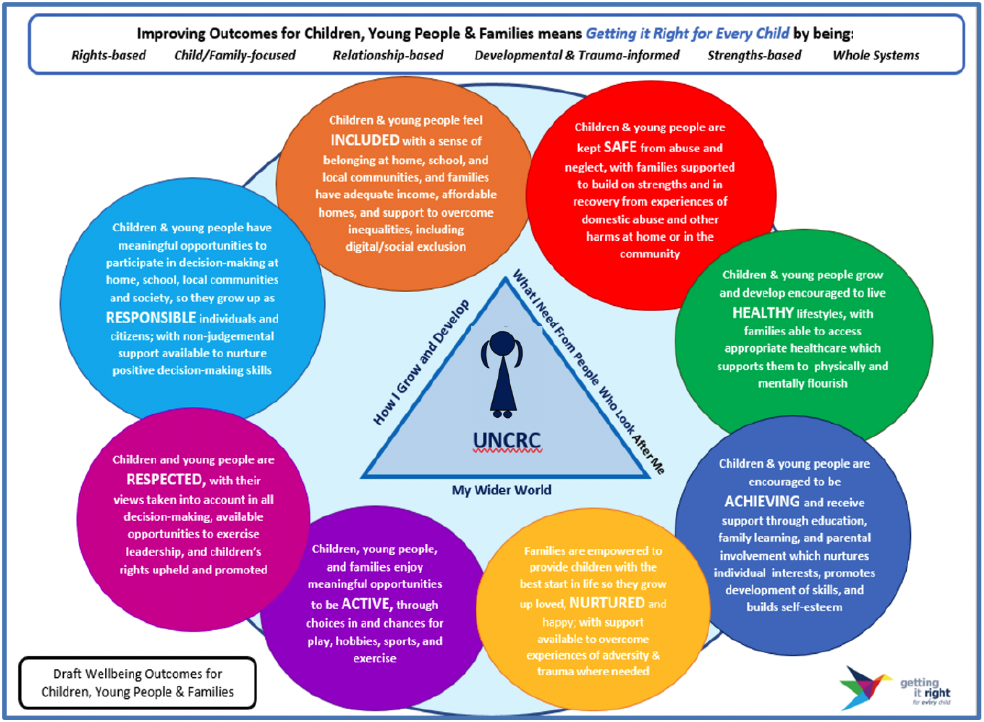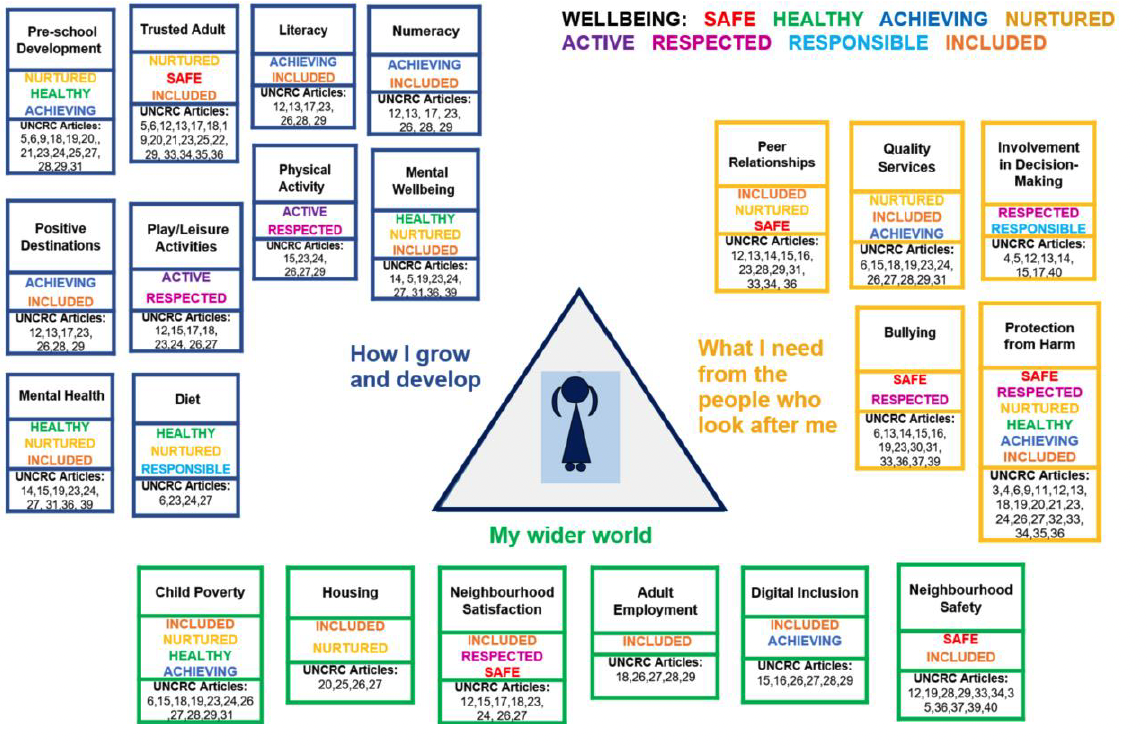Improving outcomes for children, young people and families: review of Children’s Services Plans and strategic engagement activity
Summary review of children’s services plans for 2020 to 2023, in line with the Children and Young Peoples (Scotland) Act 2014, statutory guidance part 3. Highlighting key strengths, areas for development and details from strategic engagement with local children’s services planning strategic leads.
Appendix E – Children, Young People and Families Outcomes Framework
Development of the Children, Young People and Families (CYPF) Outcomes Framework
Following a temporary pause due to the COVID-19 pandemic, work on the CYPF Outcomes Framework recommenced in early 2021, with further stakeholder engagement and a co-development approach adopted with establishment of a Steering Group and Working Group in June 2021.
Membership includes statutory services and Third Sector participants, policy leads for public service reform and the National Performance Framework, representation from The Promise Scotland, COSLA, Improvement Service Scotland, and the Care Inspectorate, with 4 Children's Services Planning Partnerships contributing to this work (Moray, Glasgow, Dumfries & Galloway, and Tayside).
The Steering Group are responsible for providing updates and making recommendations to the COVID-19 Children & Families Collective Leadership Group, with a focus on ensuring the framework's overall approach is developed in tandem with related work on outcomes, aligned frameworks and underpinning data/indicators. The Working Group had a remit of establishing a Core Wellbeing Indicator Set.
Wellbeing Outcomes and Shared Aims
Through GIRFEC, Scotland's national approach to improving outcomes for children and young people, a definition of wellbeing (SHANARRI) is well-embedded in policy, legislation and practice. Pre and post-COVID-19 stakeholder engagement established broad support for aligning the Wellbeing Outcomes with this definition, and drawing on the 'My World Triangle.' This understands babies, children, and young people's wellbeing is influenced by individual growth and development, networks of family and/or care, and the impact of local community and wider society.
Findings from a range of direct engagement with children, young people and families were analysed, with 'what matters' forming the basis for the CYPF Outcomes Framework. This sets out 8 overarching Wellbeing Outcomes (Diagram 1) underpinned by a set of Shared Aims (Diagram 2), which reflect in more detail what everyone in Scotland needs to work towards in order to achieve improved wellbeing for children, young people and families.
Engagement activity via the CSP Strategic Leads Network informed development of the Children Young People & Families Outcomes Framework, with some Children's Services Planning Partnerships facilitating direct engagement with local children, young people and families on the wellbeing outcomes and shared aims.
Core Wellbeing Indicator Set
The CYPF Outcomes Framework Working Group developed a Core Wellbeing Indicator Set (Diagram 3) through an in-depth collaborative process. The purpose of the Core Wellbeing Indicator Set is to provide a high level holistic overview of wellbeing of children, young people and families in Scotland, which highlights whether desired long term outcomes are being achieved, and helps to identify where improvements are required.
The Core Wellbeing Indicator Set consists of 21 indicators which cover key aspects of wellbeing, based on 'what matters' to children, young people and families (Diagram 4), and is holistic, reflecting all eight Wellbeing Outcomes and the three sides of the My World Triangle.
The Core Wellbeing Indicator Set is designed to be used at a local level within annual reporting on Children's Services Plans. This aims to facilitate more consistency in reporting across Scotland, but acknowledges that annual reports will continue to include additional locally-determined data which demonstrates progress of the Children's Services Plan, such as detailed indicators on specific aspects of wellbeing and other progress measures evidencing the impact of local service delivery and improvement activity.
At a national level the Core Wellbeing Indicator Set will be used as part of a developing approach to national reporting on wellbeing. Analysis will identify where there are significant differences in outcomes for particular groups of children and young people. As well as identifying trends, areas of success and concern related to the wellbeing of Scotland's children, young people and families population as a whole, reporting on the indicators will show us how well Scotland is closing any 'wellbeing gaps'. Alongside the views and experiences of children, young people and families, this will inform national and local priority setting and influence any adaptations to planning and delivery of support.
Next steps include:
- Revision of Shared Aims/ Outcomes descriptors based on stakeholder feedback
- Co-design/ development of material to illustrate practical application and support useof the CYPF Outcomes Framework in different contexts (policy, organisational, sector-specific, CSPs)
- Ongoing engagement with stakeholders to understand readiness for implementation, identifying barriers and providing support
- Development of the detailed reporting approach, collaborating with stakeholders
- Data development - mapping areas of current indicator development with identified data leads, and establish a wellbeing data networkor working group to coordinate action to fill gaps, including additional demographic breakdowns of data
- Mapping current datasets and indicators and ensuring clear connections between the CYPF Outcomes Framework, underpinning policy/delivery frameworks, and deep dive data
- Building further on identified cross-sector strategic connections: Single Promise Implementation Plan, COVID-19 Recovery Strategy, Child Poverty Delivery Plan, Wellbeing budgeting/economy.
Diagram 1 - Wellbeing Outcomes for Children, Young People and Families

Diagram 2 – Outcomes Framework Shared Aims
How I Grow and Develop
We are encouraged/supported to express our beliefs and identity and all forms of bullying, discrimination and harassment are tackled.
We are resilient, with positive mental health and wellbeing and have access to early help.
We have the best possible physical health and live healthy and active lifestyles with no barriers to accessing care or support.
We have opportunities to develop leadership and are empowered to participate meaningfully in all decisions that affect us.
We recognise our responsibilities to others and positively contribute at home, in school and to our local, national and global communities.
We are encouraged to develop individual interests and have opportunities for indoors and outdoors play, exercise, sport, recreation and culture.
We are equipped to successfully navigate key times of transition, with co-ordinated support available to overcome any barriers including into young adulthood.
We have engaging and inclusive learning opportunities which build self-esteem, knowledge, and life-skills.
Our rights are upheld and the UNCRC is fully implemented.
What I Need From People Who Look After Me
We have trusting relationships with caring and non-judgemental adults who listen to, value and encourage us, and provide our families with the right help at the right time through GIRFEC.
We grow up in loving families and homes that nurture us and keep us safe.
We have access to early support to recover from experiences of trauma and neglect.
We have the best possible physical health and live healthy and active lifestyles with no barriers to accessing care or support.
Where living with our family is not possible we stay in a loving home for as long as we need and are supported to maintain safe, loving relationships.
Where we cannot live with our family we stay together with our brothers and sisters where safe to do so.
Universally available support helps families flourish so children grow and develop healthily from pre-birth throughout childhood.
We have access to information, and advocacy and child-centred legal advice and representation.
We receive early support to prevent and reduce conflict with the law, through a rights-based approach to youth justice.
Family support feels and is experienced as integrated by children, young people, families and the workforce, through joined up help that is non-judgemental and there when needed, for as long as it is needed.
We have positive relationships with the people we live with and opportunities to spend time with people we care about.
We participate fully in co-designing services which meet the needs of our families.
My Wider World
Our home, school, online and local communities are safe and welcoming spaces, where we can connect with friends, families and communities.
Our families have locally available, affordable, quality early learning and child care, and wraparound care.
Our families live in affordable, secure and stable high quality homes which meet our needs.
Our families live in thriving communities supported by local resources, digital access, social innovation and access to sustainable, reliable transport and green space.
We live in neighbourhoods which are free from crime and antisocial behaviour and other harms.
Our families have a good standard of income, and the root causes of inequality are tackled so we grow up free from experiences of poverty.
Our families have access to lifelong training and learning and employment opportunities with fair pay.
Our communities are sustainable, and we have opportunities to make our voices heard and take action on climate change, climate justice and caring for the environment.
We are supported through pathways into sustainable positive destinations, and employment opportunities for young people with fair pay.

| Topic of Wellbeing |
Core Wellbeing Indicator |
Topic of Wellbeing |
Core Wellbeing Indicator |
Topic of Wellbeing |
Core Wellbeing Indicator |
|---|---|---|---|---|---|
| Positive destinations of school leavers |
% school leavers in positive destinations at 9-month follow-up |
Neighbourhood satisfaction |
% P5-S6 children who agree their local area is a good place to live |
Mental health/mental wellbeing |
Mean score on Stirling wellbeing scale (P5-S1 children) & Warwick Edi Mental Wellbeing Score (S2-S6 children) (WEMWBS) |
| % Children in working households |
Proportion of children under 16 living in households with at least one person age 16-64 where all individuals aged 16+ are in employment |
Bullying |
% P5-S3 children who say they were bullied in the last year |
Being listened to and involved in decision-making |
& P5-S6 children who agree adults are good at taking what they say into account |
| Digital inclusion |
% P7-S6 children with access to the internet at home/on phone/another device |
Protection from harm |
Number of children subject to Interagency Referral Discussions |
Diet |
% P5-S6 children who eat both fruit and vegetables every day |
| Peer relationships |
% P5-S4 children who agree that their friends treat them well |
Housing security |
Number of children in temp accommodation at 31 March |
Pre-school development |
% children with a concern at their 27-30 month review (as a % of children reviewed) |
| Neighbourhood safety |
% P5-S6 children who say they feel safe when out in their local area always or most of the time |
Literacy |
% of P1, P4 & P7 children achieving expected CfE literacy levels (reading, writing, listening & talking) |
Relationships |
% P5-S5 children who say they always have an adult in their life they can trust and talk to about any problems |
| Play/participation in leisure activities |
% S1-S3 children participating in positive leisure activities (at least one from list options) |
Numeracy |
% of P1, P4 & P7 children achieving expected CfE levels in numeracy |
Child poverty |
Relative child poverty rate (after housing costs) |
| Physical activity yesterday |
% P5-S6 children that had at least 1 hour of exercise the day before the survey |
Mental health/mental wellbeing |
% S2-S6 children with slightly raised, high or very high Strength & Difficulties score |
Easy access to good quality, responsive support |
% settings providing funded ELC achieving Care Inspectorate grades of good or better across all 4 quality themes |
Contact
There is a problem
Thanks for your feedback